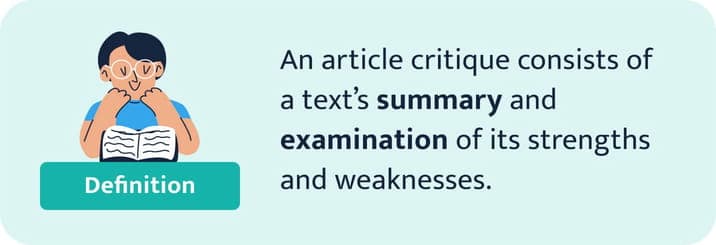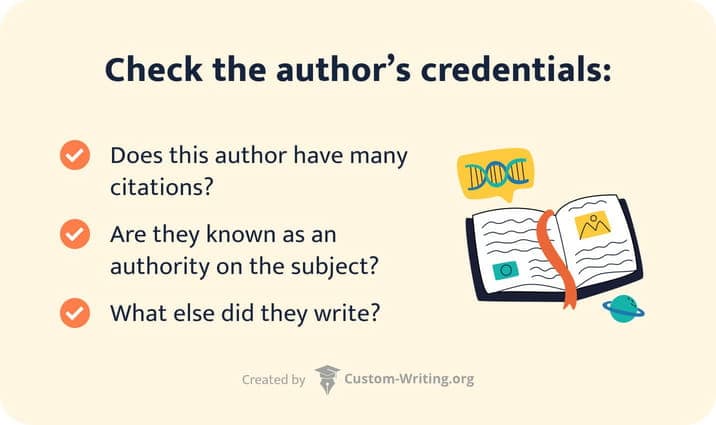Free Online Article Critique Generator for Students
Need help writing an article critique? You’ve come to the right place! This free online article critique generator will inspire you with ideas for an outstanding analysis.
🤖 Free Article Critique Generator: How to Use
- Type in the title of the article you want to analyze.
- State the name of its author.
- Paste the text of the article. Mind that you can enter up to 2000 words. If your text is longer, you can condense it using our summarizer.
- Press "Analyze" to get your customized sample review.
✨ Benefits of Our Free Online Article Critique Generator
Want to know more about our article critique generator? Check out its impressive advantages:
| 💸 Free to use | Keep your money for other purposes. |
|---|---|
| 🌐 AI-based | Cutting-edge AI ensures immaculate results. |
| ⏱️ Saves time | The writing process becomes effortless. |
| 🔍 Great analysis | Nuanced evaluation of any article. |
| 💎 Original | It creates unique texts every time. |
🔬 What Is an Article Critique?
An article critique is a type of academic writing that requires you to study an article meticulously. Typically, it deals with scientific journals, but it can also focus on other types of sources, such as magazines and newspapers.
A standard critique contains a synopsis of the article’s main points. Besides, it scrutinizes the author's claims along with the text’s strengths and weaknesses.

Article Critique vs. Summary
While the article critique recaps the text's key points, it’s more than just a simple overview:
- Aside from presenting a synopsis, an article critique requires you to review the text comprehensively and pinpoint its weaknesses and strengths.
- A summary doesn’t contain any analysis. Instead, it simply retells the text's contents.
Therefore, an article critique goes beyond mere summarization. Like any other analytical task, it requires independent critical thinking, a strong understanding of the background, and solid writing skills. More importantly, it takes time—a resource many students struggle to find. Whether you’re not feeling confident enough or just too busy, we’re always here to help! Certified analytical essay writers are ready to support you at any stage of your working process.
✍️ How to Critique an Article
Now that you know what an article critique is let's see how you can write one. It may seem terrifying and laborious, especially if this is your first time working on such an assignment. Worry not: with our guidance, the task will be child’s play.
Follow our tips below, and you'll have a fantastic article critique promptly! And if you need additional inspiration, our free article critique generator is here to assist you.
Before You Start
A successful critique starts with attentive reading. Here's how you can get the most out of it:
- Read the entire article and try to determine its main idea.
- Look up unfamiliar words to get a better perception of the text.
- Carefully reread the article. This time, focus on identifying ideas that support the text’s point.
- Summarize the article in a few sentences using your own words.
- Reread the article once again. This time, explore how the author supports their ideas. Pay particular attention to examples, facts, opinions, and biases.
- Consider if the author's ideas are persuasive and objective.

Once you’re done perusing and preparing, it’s time to start writing.
How Does an Article Critique Begin?
The introduction is the first thing your readers will see, so it's paramount to make it impressive and catchy. Here's what a splendid opening paragraph should include:
- A brief presentation of the article and its author.
- An overview of the text's central idea.
- A thesis statement that describes your observations and outlines how you will discuss the article. A brilliant thesis will help your readers grasp the direction of your critique.
What to Include in an Article Critique Body
The body is where you present and support your ideas. You can divide it into two parts: the first summarizes the article, and the second examines and critiques it.
In the summary, discuss the following aspects:
- The text’s main ideas.
- The arguments that corroborate these ideas.
- The author's conclusions or research findings.
- The broader context in which the article is situated.
After summarizing the text, you can move on to the critique that involves:
- The discussion of the article's strengths and weaknesses.
- Ethical considerations the study raises, if there are any.
- Evaluation of the research methodology or argumentation, including its potential limitations.
- Your opinions regarding the article's relevance, reliability, and clarity of presentation.
- Specific examples from the article that support your statements.
How to Write an Article Critique Conclusion
The conclusion is the final part of your work that leaves one last impression on your readers. A perfect conclusion should include:
- A very brief recap of the article.
- A summary of your analysis.
- Evaluation of the work's value, pertinence, and significance.
📑 Best Article Critique Example
Below, you will find a superb critique of a magazine article taken from The New Yorker. Check it out:
"'Film Noir': The Elusive Genre" by Richard Brody: Article Critique
The article "'Film Noir': The Elusive Genre" by Richard Brody discusses the nature of film noir. It reflects on the use of the term "noir" in defining two film series, Femmes Noir at Film Forum and Lady in the Dark: Crime Films from Columbia Pictures, 1932-1957 at the Museum of Modern Art (MoMA). The author reviews the peculiarities of film noir and compares it with other genres that can be easily recognized through visual elements or themes. The author considers the absence of the term "noir" in the MoMA series reasonable due to the historical context and the genre's unique characteristics.
of the Article:
The article examines the historical background of the term "film noir" and its absence in early discussions about the genre. It mentions the French critic Nino Frank, who invented the term in 1946. Richard Brody clarifies that French critics believed film noir movies focus more on psychological narratives and character studies than traditional crime procedurals. This made them unique and deserving of being put into a separate category. The French critics of the postwar years saw these films as a continuation of European filmmakers' endeavors to expose corruption and injustice through cinema. The article also touches on the opposition between critics associated with Positif and Cahiers du Cinéma. It dives more into the political and sociological themes that French critics appreciated in film noir.
of the Article:
Richard Brody's article gives a comprehensive historical overview of the term "film noir" and mentions its reception and the genre's development thanks to French criticism. Still, the writing could be improved if the author included the analysis of the MoMA series. The author could also elaborate on how MoMA's avoidance of the term aligns with his perspective. Moreover, the article could further explore film noir's impact and legacy on contemporary filmmaking and culture. While the historical context is well-presented, a deeper research of the genre's lasting impact would add to the article.
Richard Brody's article "'Film Noir': The Elusive Genre" effectively delves into the historical origins of the term "film noir" and its reception by French critics. The author supports MoMA's decision to focus on the element of crime rather than explicitly using the term "noir" in their series. The discussion on the historical origin of film noir as a genre and its connection to social and political contexts presented in the article helps readers understand the cinematic style better. Yet, a more in-depth analysis of the MoMA series and the discussion of film noir's contemporary relevance would add a new layer to this work.
Now, you're all set to start working on your own article critique! Our free online generator will help you find inspiration and provide you with even more examples. Try it now, and have fun!
If you're looking for further writing assistance, you can also check out our rhetorical device finder and poem checker.
Updated: